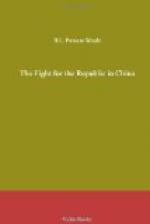This is no place to enter into the controversial aspect of Yuan Shih-kai’s action in 1898 which has been hotly debated by partisans for many years. For onlookers the verdict must always remain largely a matter of opinion; certainly this is one of those matters which cannot be passed upon by any one but a Chinese tribunal furnished with all the evidence. Those days which witnessed the imprisonment of Kwanghsu were great because they opened wide the portals of the Romance of History: all who were in Peking can never forget the counter-stroke; the arrival of the hordes composed of Tung Fu-hsiang’s Mahommedan cavalry—men who had ridden hard across a formidable piece of Asia at the behest of their Empress and who entered the capital in great clouds of dust. It was in that year of 1898 also that Legation Guards reappeared in Peking—a few files for each Legation as in 1860—and it was then that clear-sighted prophets saw the beginning of the end of the Manchu Dynasty.
Yuan Shih-kai’s reward for his share in this counter-revolution was his appointment to the governorship of Shantung province. He moved thither with all his troops in December, 1899. Armed cap-a-pie he was ready for the next act—the Boxers, who burst on China in the Summer of 1900. These men were already at work in Shantung villages with their incantations and alleged witchcraft. There is evidence that their propaganda had been going on for months, if not for years, before any one had heard of it. Yuan Shih-kai had the priceless opportunity of studying them at close range and soon made up his mind about certain things. When the storm burst, pretending to see nothing but mad fanatics in those who, realizing the plight of their country, had adopted the war-cry “Blot out the Manchus and the foreigner,” he struck at them fiercely, driving the whole savage horde head-long into the metropolitan province of




